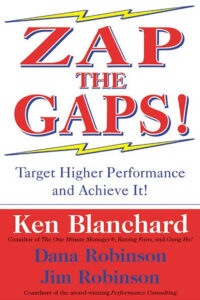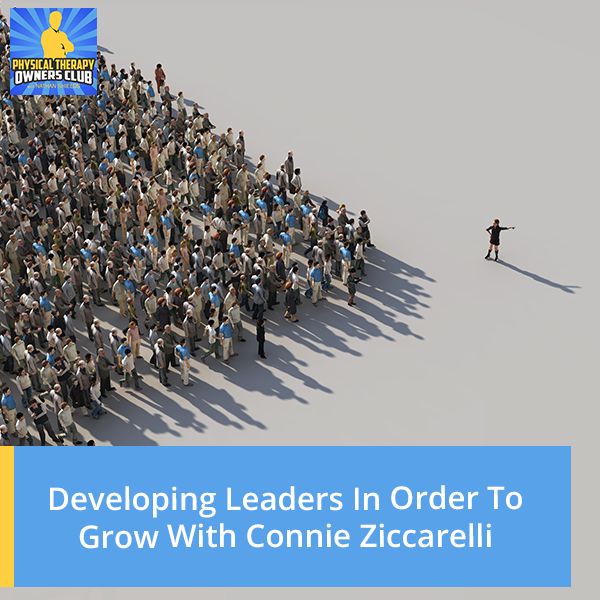
Developing leaders is necessary to have successful and sustainable growth. Nathan Shields’ guest today is Connie Ziccarelli, founder and owner of Guidepost Consultants & Mentoring. Connie and Nathan discuss how team development is like a plant. Your team requires careful planting, watering, fertilizing, and attention. Connie has spent decades creating the PT teams required to grow multi-clinic companies across multiple states. In this episode, she’ll take us behind the scenes as to how she accomplished it. Tune in and discover how keeping the team and their progress on your radar is a key component.
—
Listen to the podcast here:
Developing Leaders In Order To Grow With Connie Ziccarelli
My guest is Connie Ziccarelli. She is the Founder and Owner of Guidepost Consultants & Mentoring. She is also the past COO and Cofounder of Rehab Management Solutions. She’s got decades of history in the physical therapy space. Connie, thanks for coming on.
Thank you.
I’m excited to bring you on. I saw you through the article that you wrote for IMPACT Magazine January 2021 issue. Your comments, although a short article about leadership was powerful I thought. There’s a lot more to it. That’s why I wanted to bring you on. Thank you for doing that. I appreciate it.
Thank you for having me.

Tell us a little bit about you. With your many decades of work in the physical therapy space especially helping owners and management teams, tell us a little bit about you, where you came from and what got you to this point.
I have been working in the physical therapy industry since 1995. I started in Southeast Wisconsin and worked with two physical therapists who together we grew our network of independent practices to about twenty-plus locations in Southeast Wisconsin. Heavily active in the private practice section of the APTA, I found that physical therapists were coming to us saying, “How do you do this? How do you expand? How do you go multi-site? How do you build a team?“ We keep the consistency going and that led us to think about helping physical therapists go into private practice. That is where Rehab Management Solutions was born.
We help physical therapists go into private practice, retaining the centralized infrastructure in Southeast Wisconsin but we were in nine states. We were outpatient, independent physical therapy practices and a network. I was responsible for all of the business component of that network and those clinics. With that, I found that my passion was helping outpatient physical therapy practice owners recognize the value of their services through very proven operations and systems for billing collections, leadership development and whatnot. That’s led me to where I am.
Thanks for being willing to share your experience and advice. Your article was about having a leadership legacy. What will you be proud of? You listed four things that can help us leave a legacy based on our leadership. What was cool about your article? It wasn’t a lot about measurable statistic, incorporate this program or protocol. It was much higher level than that. It was more about coaching and developing your team. Tell us a little bit about that and where that came from.
When it comes to leadership, one of the things that I have built my career around is being a servant and a leader that is more interested in building the team than building and working on only themselves. When you take time and you build others, you eventually rise. How do we do that in a way that gets people engaged and excited about not only the practice but wanting to develop themselves? I have found that leadership is more of what you give versus more than what you take.
As people are looking to grow and that’s why I’m excited to have you on as you grew so much with so many locations. One of the issues that PT owners have as they tend to expand and bring on other people especially other locations is that’s when any weakness in the boat is going to get magnified. That leak or that hole in the boat is going to grow larger and you start losing some of the characteristics that made you grow it to begin with. That’s where you were going with the leadership legacy. How do you maintain what you started with and maintain that character, the identity, the personality of your company even as you grow in size?

First and foremost, you’ve got to have a set of value goals. What makes you or your practice click? What are going to be the guideposts that you’re going to rely on when you go multi-site or even if you want to bring on more staff? Who are you? If you don’t know who you are or who you are as a leader, who you are as your practice, you’re not going to have anybody buy into it. One of the things that you have to start out with first is you have to have a set of value goals. Who are we? What are we going to believe in? What is our mission? How do you communicate that? Do you communicate that in your words? Do you communicate that in your behaviors? People follow what they see, not what they hear. I find that the value goals have to be a living and breathing part of the practice so that people are following and feeling it.
I love your first sentence under step number one. Developing a leadership legacy is leaders explain why and not the how. It goes back to Simon Sinek’s popular TED Talk about the why. People buy the why, not the what. It’s the same thing with your team members. Your team members aren’t buying into you because you provide great physical therapy. Your team members are expecting that and they’re working hard to provide that great therapy. The reason that they’re on your team and they’ve bought into your company is they believe in your why.
I spent a lot of time with my coaching clients and I’m sure you do the same as well at the very beginning, establishing that why, that purpose and also the values. Initially, I know my clients have given me feedback further down the road. I didn’t think those things meant anything. It didn’t feel like I was getting any traction going anywhere but as they’re trying to expand and hire more people and looking at the locations, that purpose and those values are the bedrock. They are the foundation for that future growth.
That’s a great point. The why is it. If you don’t know that yourself, it’s time to step back and reflect on that. We hire staff and they come to us because they need a job where they want a paycheck. If you want to be successful, it’s up to us as owners and leaders to instill in them the why and to communicate that so that it becomes a mission. It’s not just, “I’m picking up a paycheck.” It’s that you’re engaged in the practice and in the direction that you’re leading.
It’s one thing to hire somebody on to fill a spot. Someone might take that spot because they need a job. If they’re going to stay and if you’re going to grow then higher level things need to be addressed, as in the purpose and the values. When someone is purpose and value aligned, they will then stay in your company, you will have less turnover and that’s when you start developing your leadership teams.
When you take time, and you build others, you eventually rise. Click To TweetOne of the things that I’ve found is that once they become engaged in your mission and they’re living these value goals, all of a sudden, they’re contributing ideas. They’re contributing activity. They’re contributing growing others. Once you see that in your practice, you are starting to cook with guests, you’re getting raving fans from your patients because they feel it. You can’t have a raving fan if you don’t have raving employees, if you don’t have raving team members. I mean raving in a good way, raving happy, raving joy and good vibration. You feel that when you walk into a clinic. I have always found that people see that smile over the phone. If they’re not feeling it over the phone, they’re not going to feel it when they walk in.
Your step number two is about staying people-focused. Talk to us a little about being people-focused. Sometimes as physical therapists, we tend to be pleasers. We might keep someone on the bus who maybe isn’t value-aligned but they’re doing the bare minimums. How do you stay people-focused but then still stay accountable to performance statistics?
I’m going through that with a client. I’m not a physical therapist but I’ve surrounded myself with amazing physical therapy partners for many years. One of the things that I’ve found to be the most endearing quality of a physical therapist is their heart. They go into this business because they’re touchy feely people. They’re not a surgeon that cuts and leaves. They are hands on in the middle of people’s lives, helping people get to that next level, whatever that is. On the other side, that sometimes is a weakness because you keep people on maybe longer than you should. The expiration date has happened. It’s hard to pull it out of the refrigerator. Clearly, that feeling of mentoring and that feeling of working with your team needs to be always fresh.
I feel that if you don’t know who you are, where you want to go and you’re 100% solidified, “This is the direction of my practice,” it will be hard to do some weeding. Clearly, you got to weed. A tree blooms better the next spring if you prune it in the fall. It’s critical and I say to look at your practice every quarter. Take a look and reflect on how everybody is doing on the staff, from your administrator team down to your clinical team, to your support staff, to your cleaning team. Is everybody aligned to the mission? If not, then it goes into mentoring. If people can’t come around through your mentoring, then maybe it is time to re-look. It’s so hard to find staff. It’s hard to get that learning curve. I do believe in mentoring and giving people the opportunity to shine. There’s time when it’s time to move on.
A good question that my partner Will Humphreys uses quite often in that quarterly assessment could be something like, “Would you enthusiastically rehire this person if you have the opportunity again?” That could give you a good barometer about where you land. Maybe a follow-up question would be, “What is it that they need in order to do better in your facility? Would they be a rising star somewhere else and figure that out quickly?” If you have strict values, that makes the decision process a little bit easier. Number one, it’s easier to hire and fire somebody if they don’t go against your values. Number two is as you’re assessing their progress, which of those values could they better exemplify? Which of those values do they need help with and where do they shine? You can have that kind of assessment readily available if your values are established prior to.
One of the other things I take into consideration as well is how does the rest of the staff feel about this person? You look at professional teams. They’re a mixture of different personalities. I remember Michael Jordan in the day. Remember the Bulls in the day? You had Jordan. You had Rodman. You had Scottie Pippen. Would they hang out at night and eat dinner together? Probably not but they respected each other on the court and they were a winning team. I take the same with my staff or with my team. I’m going to have a lot of different personalities. Everybody contributes. Do they get along as a team? Are they winning as a team? If you can’t answer that and they’re not wanting to be a part of a winning team, then you’re right. They probably would shine somewhere else. It sure is great when you have that conversation and you see the light bulb go on. You see self–redirection and they turn around. You keep moving forward.
The third step is set the conditions. As we’re going over this conversation, it’s not all about the fields and how the other team looks like so much. There is part of it that it is statistic-driven. Your first sentence was organizational performance increases when clear and precise expectations are given and outlining clear roles. One of our main phrases back in the day was production is the basis of morale. That was a clear condition that was set. We had specific statistics and guidelines to follow and measure so that we know that the expectation is there and it’s not assumed. You never want that. People can always feel busy whether they’re productive or not. A sense of busyness shouldn’t be the barometer. There should be some clear guidelines and expectations.

You can be busy going out of business. Busyness is not the barometer. I feel that as a leader or a practice owner, that’s some places that not only are you going to have that emotional intelligence. You’re going to have a clear vision of where you want to go. You’re going to have exactly what your practice is going to be. More importantly, what it’s not going to be. One of the other things that you have to consider is you have to have a performance matrix. If you want to service a community, you’ve got to be for-profit. It’s not a bad word to make money. It’s not a bad word to reinvest it. You have to have a performance matrix.
When you clearly define that, you set up guideposts along the way to make sure that you’re hitting these things and you’re clearly reporting the good with the not so good with your teammates, with your staff, everybody is going to rally around it. When the scoreboard says, “We’re down by ten.” It’s halftime. You rally that team and you come back and win by fifteen. How much greater is the next game going to be? You’ve got people that don’t want to talk about the hard stuff. They don’t want to talk about when maybe they didn’t hit the mark. That to me is when you’ve got to step up. You had to step up as a leader and say, “We missed it. Can you help me understand why we missed it or why you missed it,“ and get the opportunity and give some suggestions to redirect?
One of the best books that I have found in redirect is called Zap the Gaps! by Ken Blanchard. It’s a great tool when you want to build your team. If you don’t mind, I’ll tell you how I use it. It’s a great little parable. Ken Blanchard makes great books that are fast reads, The One Minute Manager Meets the Monkey, Whale Done!, all these books. The Zap the Gaps! helped me and has continued to help me in finding variants. When you incorporate people into this concept, they tend to find their solutions and help fix it.
Zap the Gaps! is you identify the cause. You identify the issue. You put solutions in place. You work on those solutions. You don’t automatically jump to solutions until you find out the causes. Let’s list all these causes that could be potentials. You put solutions to those causes and we’re all working together. Expectations are very important. Productivity is important. It’s part of the mix. How you communicate that and how your team adopts it is where you’re going to shine as a leader.
One thing that comes to mind is so many clinic owners can focus on total visits. They might see their total visit numbers go down, so now there’s a gap. There’s an expectation and we’re hitting below that so there’s this gap. It needs to be properly diagnosed. What are the problems? A lot of owners might default to, “We need more new patients,“ when that might not be the case at all. You might have plenty new patients but our patients are falling off after three visits on a regular basis thus not completing their full plan of care. Is the arrival rate poor? Are your patients only coming in 0 to 1 time a week versus 2 to 3 times a week? Are you measuring some of these things? I love that you brought that. That was one thing that came to mind. There’s an easy default to, “I need more new patients.“ We need more new patients when there’s so much more of the work that can be done underneath.
In fact, I have a Zap the Gaps! worksheet on my website. If anybody wants to go on, they can download it, play with it, use it or get Ken Blanchard’s book.
You have to share your website. Where do we get the Zap the Gaps! worksheet?

GuidepostConsultants.com. It’s a free download too. Give it a try and see if it helps. One of the places that physical therapist owners look is that clinical production side or the clinical matrix. It’s one of the places that I strongly encourage people to look and put goals in places on the administrative side. Your nonphysical therapy team is as important in revenue producing as well as your clinical team. I find that having those conversations and those benchmarks in place for both sides of the practice, the clinical side and the nonclinical side, cements the team and brings it together.
A lot of practice I go into there’s this divide. The PTs are over here and the administrators are over here. What I like to do is build that bridge and say that if we don’t have both clicking at the highest level, this practice won’t be at its highest level. It’s like having your offense and defense in sync. You could have a great defense but you don’t have a quarterback making points. I believe in investing in the clinical benchmarks as well as the administrative benchmarks.
The clinical benchmarks are going to be easier for owners to come up with. They’re pretty obvious. What are some examples of administrative benchmarks that PT owners need to be aware of? They might feel a little uncomfortable to weight into that space because they don’t know as much. What are some benchmarks they can use to hold their administrative team accountable?
Some easy ones right off the bat are collections at the front desk. What is your collection rate at the front desk? How are we holding them accountable for that? What are those matrices? Another one is days outstanding. What’s the turnaround time to get paid? You see the visit. You get the bill back as a paid reimbursed service. What’s that timeline? Can we shrink that or turnaround of money? What is our documentation timeline? How long does it take for a documented visit to get turned into a claim and build out? You’ve got denial rates. What is your denial rate? How fast are you turning around those explanations of benefit? If you get them on Monday, do they sit for 60 days?
These kinds of things are great. Plus, it gives you an opportunity to evaluate that team member that does those skills. Some people say, “How do I find an administrator? How do I know if they’re doing well?” If you’re not putting goals out there and benchmarks, you don’t know. Those are some things that I encourage practice owners to invest in, to look at and to be very critical. If you can measure it, you can put a goal to it. If you’re out there measuring things with your practice, you can set goals up for that teammate who’s responsible for it.
I might be getting ahead of myself but I want to talk about how do owners do this, especially those that might be treating a lot. Where do they find the time? How do I find the time to do all this stuff? I think it’s essential for them to recognize that as the owners and as leaders, it’s their responsibility to take the time and set the time aside rather than treat that patient to do these things for the behalf of the business.
They can’t make somebody do something and they don’t have to. You can continue to treat and you can continue to have a practice but maybe that practice won’t grow as fast or as well as maybe you want. If you want growth, you’ve got to invest in planting. You’ve got to invest in watering. You’ve got to water your staff. It’s like any garden. You got to put fertilizer on there. Sometimes that feedback maybe isn’t what they want to hear but you got to do the hard stuff. You do have to carve out time. If you want to grow and you want to have a staff, it’s going to take time. It has to be your time as the practice owner. That’s one thing you can’t delegate out.
That feedback is essential. That’s your fourth step in articles. Feedback is key. The watering like you’re talking about giving feedback on a routine basis. I used to think of them as flybys. Just go by the front desk and say, “How are things going? What can I do to help? Is there anything else you need?” and then move on. There are times it’s necessary to have more in-depth conversations but having touch points on a routine basis is essential.
I call them touch points. If you let your annual review system be the only time you give feedback, you’re missing out on a lot of growth. I find reasons to comment to people or staff. I find excuses to go out of my way and give compliments. I have benchmarks where I can use redirects as a way of getting people to turn around or getting someone to identify something. Annual reviews are not going to get you where you want to go. It’s those touch points. It’s using your ability as a physical therapist to engage with your patients and finding reasons.
As a physical therapist, you’re going to have this plan of care. You’re going to ask these questions that make sure the patient is doing their home exercise program. You’re going to be asking questions on how they’re doing in their plan of care. It is no different with your staff. You have a staff that needs you and need your questions just as much as your patients do and anytime that you have a reason to reach out. Recognition and reward don’t have to break the bank. There are many ways that you can recognize and reward your staff without spending a dime A handwritten note, a thank you note left on somebody’s desk. Studies have shown it’s far better than a verbal compliment. I’ve been known to send a note home to my employee’s family, thanking them for the extra effort that someone has put in through the month. Those kinds of things are where you’re going to grow as a leader because you’re growing others.
Leadership is more of what you give than what you take. Click To TweetIf you don’t have the brain space, the bandwidth to think about them, if you’re constantly into whether it’s paying the bills or treating the patients or you name it. If your head’s full of other things then it’s hard to consider those people on your team and what they need.
Some of the hardest clinics I’ve walked into is when they have a swoop down and poop on your head approach to redirection where there’s only feedback when things go wrong. If you focus on the right and do feedback on all the positive things that are happening, all of a sudden, the negative stuff start going away. Ken Blanchard has a great book on that, Whale Done!: The Power of Positive Relationships. Some of those principles alone has been amazing in my growth and in getting a staff excited about doing the right thing.
That goes so far because many times, as we set the conditions, which was your step number three and set the expectations, many teams can come back. I’ve heard it before. They’ll say, “You’re all about the numbers.“ Do you think that’s their way of saying, “Are you caring about me as an individual at all? Is this all about you and your company?“ I’m getting that feeling as we’re going into this conversation that if you’re not backing up those expectations care about them as a person. That comes in the form of compliments, recognitions, rewards but also assessing when talking to them about what their individual goals might be, how you can help them pursue their professional and physical goals. When you come at them with statistics, they’re going to be like, “What do you care? It’s all about the numbers to you.“
It’s a balance and it’s a dance. You’ve got to have performance and you’ve got to have a matrix that let your business stay in business. You’re in business to stay in business. How do we marry that up, gently walk around and use our emotional intelligence while we’re using our business acumen? It’s marrying that up that is the art. The science is we’ve got to have numbers but yet we got to have a staff. The art is how do we make it all integrate?
What does that do for people, for owners who want to then make this a multi–clinic practice? How does this benefit those who are looking, “I want 2, 3, 4 clinics eventually. I might want to go to a different state. I want to grow this large. I want to blow this up?” What does this all do for them? Why do they have to go through this process?
I started way back in the day at McDonald’s. I was the hostess at McDonald’s when McDonald’s had a hostess. This was a long time ago. One of the things that always impressed me with the McDonald’s organization is that you could get a Big Mac in any state and it was the same. I take that as how do we go to multi-site, multi–location and still have our “Big Mac“ the same? It comes with setting the values. It comes with clearly explaining what expectations are, what your company is and what your company isn’t. Developing a small band of leaders that will go out and follow that process, proven ops and systems. You’ve got to take copays in the same way at one location as you do in the other location, down to your treatment facility, your treatment area. Is it set up the same so the physical therapist and the staff can feel like they can interchange with offices if they need to do coverage?

How does that feel? One of the best ways to predict your future is to create it in your first location. Get your team to rally around that. Start with your second location and make sure that it is feeling the same way before you even stepped into 3rd or 4th. If you want to go big, you’ve got to have your ops and systems in place. You’ve got to have your team in place. You’ve got to have a clear vision. More importantly, as the leader or as the owner, you’ve got to be able to recognize and talk back to your team clearly and precisely the way they have to go.
Some of the dirty work that was always hard for me is to look inside. What do I want? What is the purpose? Let’s clearly define the values. That takes a little bit of work. It’s easy to flyby the seat of our pants, get things done and see the bank account do okay. It’s harder to sit back and take the time to think about what I do want, what my career vision is and what my values are. That can be dirty work. What’s even worse for me is writing down those ops and procedures, grinding that stuff out. Once you can dial it down that allows for an opportunity for growth.
You surround yourself with people that are as good or if not better than you. If you surround yourself with those kinds of people and have that philosophy, you’re going to rise to the top. One of the things that I have found is good leadership books. Some books that will give you that next leg up. Surrounding yourself with individuals like the private practice section has been phenomenal for me because it has surrounded me with people that are 2 or 3 steps ahead of me. I’ve got to mentor 2 or 3 people that are 2 or 3 steps behind me. What are the other things that I have found to be very helpful in growing a business?
Looking at who you are as a leader and as an owner is journaling. Start a business journal. You hear everything around you. “I journal this or I journal that.” That’s more on a personal level. If you start writing down areas that you want to work on and areas that have been a success, the more you write that down, the more you’ll come back to it and stick to it. I have found that journaling has helped me in my career more than anything else, surrounding myself with the right people and journaling.
I love your recommendation also about finding the right people. Those people who have bought into your why are the same people that you’ll say, “You tend to do your position very well. Could you start writing down your successful actions and what you do on a daily basis?“ All of a sudden, that takes the onus off of the owner to start developing job descriptions, policy and procedures. The team starts working with you and you‘re leading at that point.
That would be a great quarterly exercise and a great way to have a way to evaluate. They’re writing their top review or performance review. You sign off on it that this is the way you want to go. You’ve got to clearly know the way you want to go before you can sign up on somebody else’s definition of it.
You don’t want someone who’s barely making it and barely surviving in your clinic to be that person that writes that up. You want someone who is performing incredibly well. Their numbers are great and they have a great rapport with everybody before they start writing up something like that. What are some of the books that you might recommend?
I do follow Ken Blanchard quite a bit, as you can see. They’re short, fast reads. One of the other ones that was very instrumental on getting us to a multi-site, multi–location was the book Nuts!, how Southwest Airlines was developed. That book helped set the stage on creating raving fans. How do you want to get people to buy into your name, buy into your business? That was a very good book.
The E-Myth Revisited, Good to Great or Traction by Gino Wickman. All of those are great.
The Untethered Soul. I know that it’s not a business book per se but that is a great book on self-development, getting a clear mind of who you are and who you could be as a leader. It’s a great book.
We followed one similar to that called Leadership and Self-Deception. It was business-minded but you could read it as an individual who didn’t own a business and still gain a lot from it. What I tell my clients is, “Your leadership development program consists of the same things that you did to develop yourself as a leader.“ The books that you think are essential in your growth are the same books that you would expect your leadership team to start developing. If you’re going to coach or mentor yourself as an owner, then your team should have a coach, a mentor. That could be you. That could be someone else that you trust. Your leadership development program is essentially the same things that you did and others have done to progress as leaders.
I do mentoring myself. I like taking people on and sharing the books that helped me get to where I am, see if they resonate with them. Doing that, you find out what makes people tick. They may find one book over another book. It’s better. You have a path of what makes them tick. One of the best things that has happened to me and I’ve turn moved it on is if I find a book that has helped me, I get one for my mentoree. I write a personal note in there. Send it off and leave it with them. If you have a book that has been super impactful for you, buy it for your team. Put a handwritten note inside, hoping that this is great for you. Date it. Leave it for them. They’re going to read it a lot faster than if you tell them to go out and get the book. Give it as a personal gift. That is what I’ve found encourages people to get into reading.
That happened to me in 2020 with a friend of mine, Mark Moore. He was a fellow PT school graduate of mine. He sent me Who Not How by Dan Sullivan. I was like, “If you love it enough to buy it for me then I’ll read it.” I read it. It changed my perspective entirely. I have shared it with I don’t know how many people, 5, 10 people saying, “This is life-changing. You got to check it out.“ I’ve been through that same exercise. I can attest to it. It’s great. Is there anything else you’d like to share? We covered a lot of stuff in your article and then some. Any other thoughts of wisdom as it pertains to developing leaders and how that correlates with growth and expansion?
If you don't know your 'why,' then it's time to step back and reflect on it. Click To TweetIt’s going to go back to knowing your own heart and knowing where you as a business owner and a clinical leader want your business to go. If you clearly understand it in yourself. I find journaling helps sort some things out. You can tell that to your team. Start with one person that you would like to invest in that you think has those seeds that you see in yourself. That could take your team to the next level. Start some one-on-one mentoring. There are people out there that are writing books. For myself, I’m doing mentoring that offer support and help in that area. Don’t forget your administrative team. They’re very much an integral part of the practice. Working with them, setting goals for them and investing in them along with your clinical staff is going to go so far.
If that front desk person is happy, it changes the entire attitude of the clinic.
The people that are working with your patients to pay off a bill, they better be happy, engaged people or you’re not going to get a return patient.
It’s interesting that as we talk about this with our teams, how much of that flows over to patients when you start developing that culture. What we’re talking about is developing a culture over time that none of the employees will buy into. To the point where ours have said in the past, “I know I could make more money elsewhere but I wanted people to give the rest of my life, if I can.” You have those people that have bought into the culture. That carries over to patient care. The patients recognize that. They want to be a part of that as well. They start inherently buying into your why, not so much of your what. They could possibly get better physical therapy elsewhere but they’ve bought into you and your culture that you’ve developed at your company.
I’m going to take that one step further. It goes into the referral sources. It goes into your payer contract reps. It goes into the authorization teams that give you your visits, your utilization companies. It permeates everywhere. Going back to our example, that maybe productivity was down and you need new patients, you may not have a new patient problem. You may have a culture problem. It permeates everywhere. You want to have that engaged and excited staff from the person who cleans, to the person that takes money, to the lead therapist that is so booked, to you as the PT owner.
Thank you so much for taking your time and sharing your wisdom. If people wanted to get in touch with you, Connie, how would they do that?
My website is GuidepostConsultants.com. You can email me at Connie@GuidepostConsultants.com.
Thank you for your time. I appreciate it.
Thank you.
Important links:
- Guidepost Consultants & Mentoring
- TED Talk – Start with why by Simon Sinek on YouTube
- Zap the Gaps!
- The One Minute Manager Meets the Monkey
- Whale Done!
- Nuts!
- The E-Myth Revisited
- Good to Great
- Traction
- The Untethered Soul
- Leadership and Self-Deception
- Who Not How
- Connie@GuidepostConsultants.com
About Connie Ziccarelli
 Connie Ziccarelli owns Rehab Management Solutions located in Mt. Pleasant, Wisconsin, and has been in business since 1995. The business provides practice management solutions and has outpatient physical therapy clinic locations in several states with over 100 employees.
Connie Ziccarelli owns Rehab Management Solutions located in Mt. Pleasant, Wisconsin, and has been in business since 1995. The business provides practice management solutions and has outpatient physical therapy clinic locations in several states with over 100 employees.
Love the show? Subscribe, rate, review, and share!
